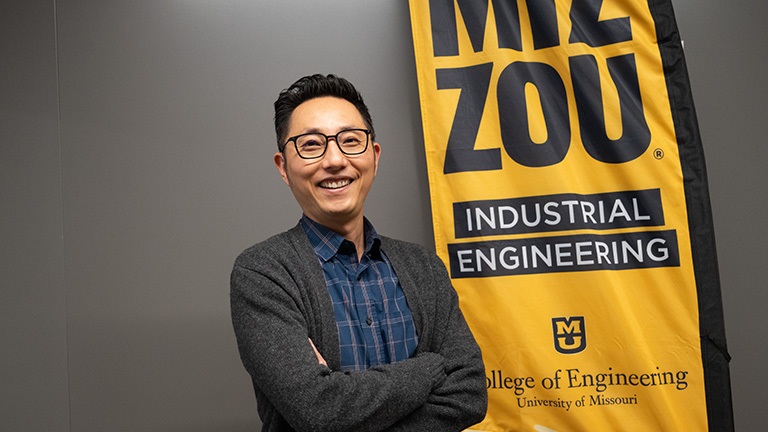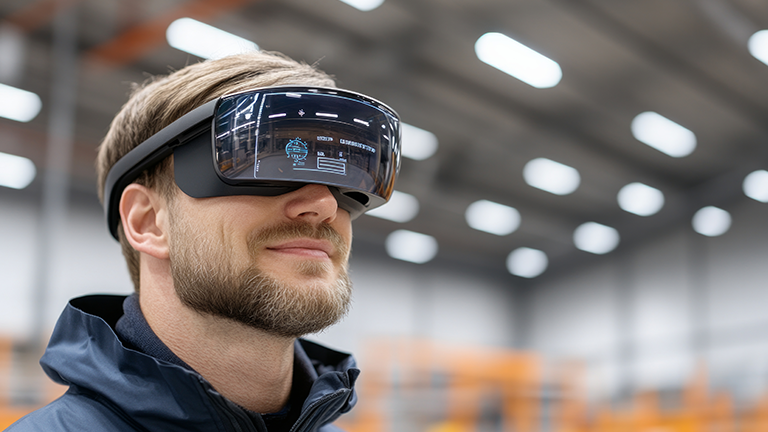January 27, 2025
Interdisciplinary discovery has broad implications for workplace policies and safety regulations.

Finding answers to tomorrow’s issues today is a hallmark of excellence at Mizzou. Researchers here are now exploring how augmented reality (AR) technology will affect workers and learners in the future.
AR devices have been around since at least 1999, when the U.S. Naval Research Laboratory prototyped a wearable system as a training tool for soldiers.
As AR technology has begun to proliferate, it is becoming apparent that wearable devices like AR goggles can cause fatigue after prolonged use — a major issue for users and manufacturers alike.
“Many people were very excited about Apple’s Vision Pro. But many users often felt an overwhelming sense of fatigue after using the device 40 or 50 minutes,” Jung Hyup Kim, associate professor in the Department of Industrial and Systems Engineering, said. “They spent thousands of dollars on this device, but they are reluctant to use it because of the physical discomfort they experienced while using it.”
Up to now, measuring the physical demand of using AR has been difficult. The only method has been through subjective surveys like the NASA Task Load Index, which asks users about their physical and mental fatigue.
However, Mizzou researchers found the answer in AR users’ posture.
“Upon measuring the degree of slouching exhibited by AR users, we found that those measurements could be correlated to physical demand,” Kim said.
The research was recently published in the journal Ergonomics. Kim co-authored the paper with Varun Pulipati, then a master’s student in computer science; Fang Wang, associate teaching professor the Department of Engineering and Information Technology; Danielle Oprean, assistant professor in the School of Information Science and Learning Technology in the College of Education; and Kangwon Seo, associate teaching professor in the Department of Industrial Systems Engineering.
Enhancing everyday life
The research team found that physical discomfort was partly the result of the weight of the AR goggles and partly the task they were performing in AR.
The implications of the research extend to workplace policies, safety regulations and health care.
“The more we integrate AR into our daily work, the more important it becomes to understand its physical demand so we can optimize productivity and well-being,” Kim said. “We can’t expect a factory worker to wear goggles throughout a 40-hour work week due to discomfort and strain.”
This is just the beginning, Kim said. In the future, advanced systems could recognize when AR users are fatigued and encourage breaks, similar to how modern cars can monitor driver attention and behavior.

The research is a step toward quantifying the physical demands of AR, which will help improve device design and worker safety as AR technology becomes more widespread.
Kim’s work opens opportunities for automating the optimization of learning experiences, much as a teacher would in one-to-one instruction, allowing for tailored educational strategies.
“If I see from your posture that you’ve had a tough day, I will adjust my teaching approach to better align with how you’re feeling,” Kim said. “If we can measure physical fatigue levels, we can provide more personalized training for workers, for example, and make future learning platforms smarter.
The same technology could deliver real-time insights to help optimize performance and safety in various settings, identifying when truck drivers need to rest or when a hospital is exceeding safe nurse-patient ratios.
Addressing human needs
Mizzou Engineering is a rich environment for collaboration, Kim said, pointing out that his co-authors work in different departments and colleges.
“This is the beauty of Mizzou Engineering. You have a vibrant community of diverse expertise in the same place,” he said. “Everyone here is eager to share their ideas and work together as a team, and that’s especially important in this kind of research.”
The interdisciplinary team dynamic at Mizzou Engineering encourages forward-thinking research on emerging technologies.
“In Industrial and Systems Engineering, there is an enthusiasm among faculty and students for exploring hot topics — AI, big data and so on. We stay ahead of trends and are pioneers in our field, so when the future arrives, we’ll be able to say, ‘Oh, Mizzou already did that a decade ago,'” Kim said.
Kim emphasizes that the goal of this research is not just technological advancement but addressing human needs.
“Most people think engineering is all robots and computers and that engineers are emotionless beings,” he said. “The truth is that we want to harmonize emerging technologies with human needs, ensuring our innovations improve the quality of life in our world.”
Work with innovative researchers solving real-world problems. Apply now!